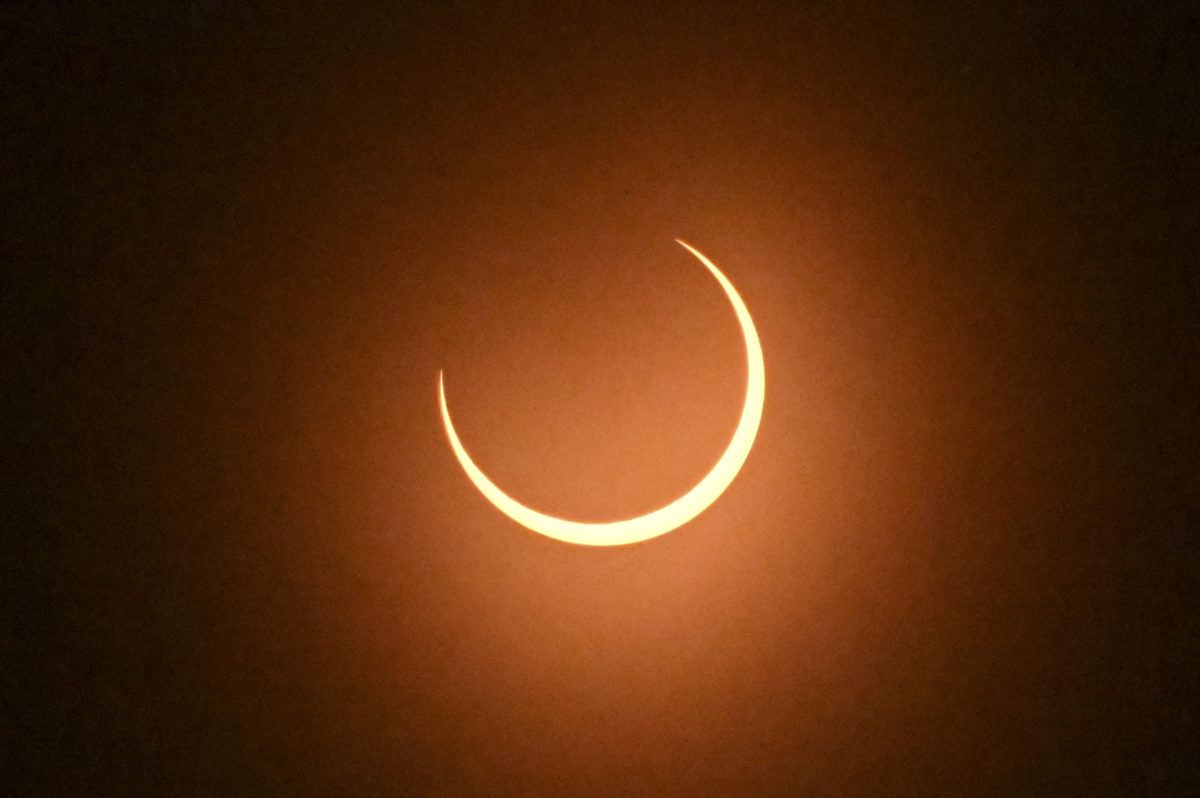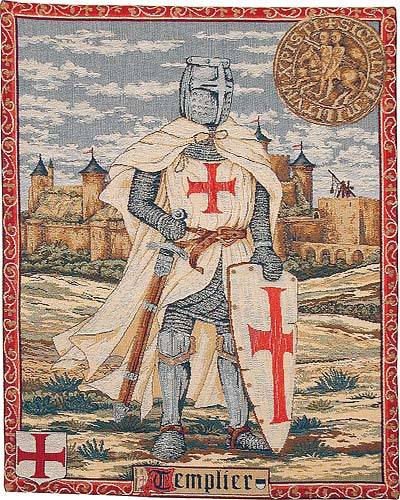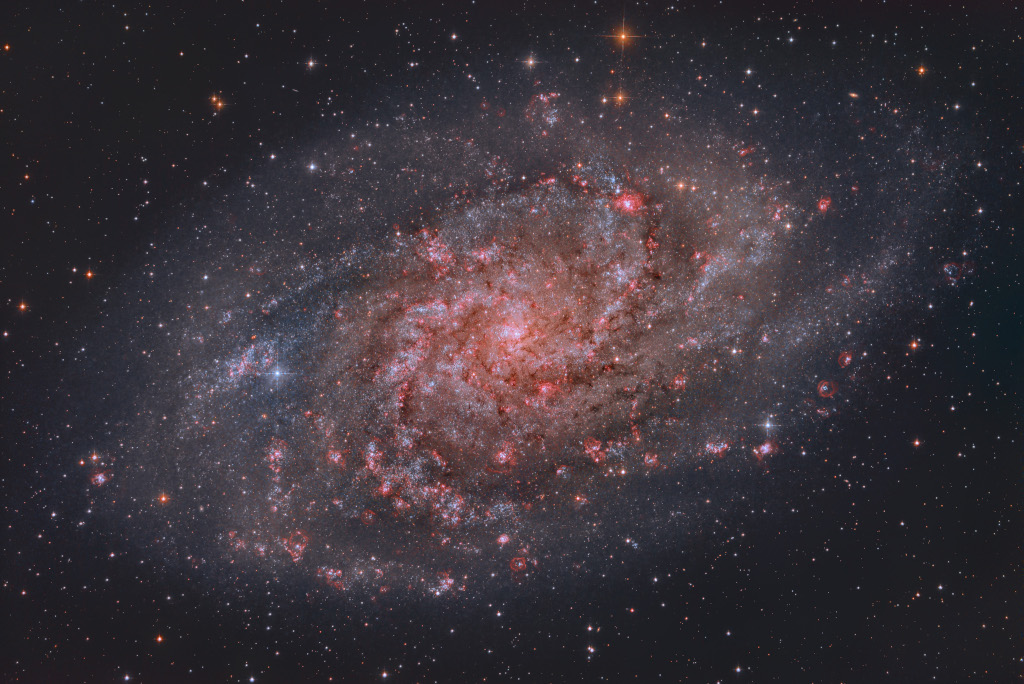Cheers erupted among crowds in Oregon and New Mexico on Saturday as a rare “ring of fire” eclipse of the sun that had millions across the Americas waiting with anticipation began putting on a spectacular show.
With the presence of cloudy skies, a NASA livestream of the phenomenon reported it in Eugene, Oregon, shortly after 9:15 a.m. local time. This came over an hour after a partial eclipse set in.
For the small towns and cities along its narrow path, there was a mix of excitement, worries about the weather and concerns they’d be overwhelmed by visitors flocking to see the celestial event, also called an annular solar eclipse. Clouds and fog threatened to obscure the view of the eclipse in some western states, including California and Oregon.
As totality began in Eugene, Oregon, oohs and ahs combined with groans of disappointment as the eclipse was intermittently visible, the sun’s light poking through the cloud cover from behind the moon only at times.
In New Mexico, the sky was crystal clear, giving tens of thousands of spectators an unfettered view. They got a double treat since the eclipse coincided with an international balloon fiesta that draws close to 100,000 spectators for early morning mass ascensions of hundreds of colorful hot air balloons.

The moon crosses in front of the sun during the annular solar eclipse on October 14, 2023, as seen from the Astronomical Observatory of the National Autonomous University of Honduras (UNAH) in Tegucigalpa. (Photo by Orlando SIERRA / AFP) (Photo by ORLANDO SIERRA/AFP via Getty Images)
Fela Aníkúlápó Kútì (born Olufela Olusegun Oludotun Ransome-Kuti; 15 October 1938 – 2 August 1997), also known as Abàmì Ẹ̀dá, was a Nigerian musician, bandleader, composer, political activist, and Pan-Africanist. He is regarded as the King of Afrobeat, a Nigerian music genre that combines West African music with American funk and jazz. At the height of his popularity, he was referred to as one of Africa’s most “challenging and charismatic music performers”. AllMusic described him as “a musical and sociopolitical voice” of international significance.
Kuti was the son of Nigerian women’s rights activist Funmilayo Ransome-Kuti. After early experiences abroad, he and his band Africa 70 (featuring drummer and musical director Tony Allen) shot to stardom in Nigeria during the 1970s, during which he was an outspoken critic and target of Nigeria’s military juntas. In 1970, he founded the Kalakuta Republic commune, which declared itself independent from military rule. The commune was destroyed in a 1978 raid that injured Kuti and his mother. He was jailed by the government of Muhammadu Buhari in 1984, but released after 20 months. He continued to record and perform through the 1980s and 1990s. Since his death in 1997, reissues and compilations of his music have been overseen by his son, Femi Kuti. On 3 August 1997, Kuti’s brother Olikoye Ransome-Kuti, already a prominent AIDS activist and former Minister of Health, announced that Kuti had died on the previous day from complications related to AIDS. Kuti had been an AIDS denialist, and his widow maintained that he did not die of AIDS. His youngest son Seun took the role of leading Kuti’s former band Egypt 80. As of 2022, the band is still active, releasing music under the moniker Seun Kuti & Egypt 80.
see full post...Lionel Frederick Cole (October 15, 1931 – June 27, 2020) was an American jazz singer and pianist whose recording career spanned almost 70 years. He was the brother of musicians Nat King Cole, Eddie Cole, and Ike Cole, father of Lionel Cole, and uncle of Natalie Cole and Carole Cole.
Freddy Cole was born to Rev. Edward J. Coles and Perlina (Adams) Coles, and grew up in Chicago, Illinois. His brothers Nat “King” Cole (1919–1965), Eddie (1910–1970), and Ike (1927–2001) also each pursued careers in music. He began playing piano at the age of six, and continued his musical education at the Roosevelt Institute in Chicago. He moved to New York in 1951, where he studied at the Juilliard School of Music before completing a master’s degree at the New England Conservatory of Music.
see full post...MacHouston “Mickey” Baker (October 15, 1925 – November 27, 2012) was an American guitarist, best known for his work as a studio musician and as part of the recording duo Mickey & Sylvia.
Baker was born in Louisville, Kentucky. His mother was black, and his father, whom he never met, was believed to be white.
In 1936, at the age of 11, Baker was put into an orphanage. He ran away frequently, and had to be retrieved by the staff from St. Louis, New York City, Chicago, and Pittsburgh. Eventually the orphanage quit looking for him, and at the age of 16, and he stayed in New York City. He found work as a laborer and then a dishwasher, but after hanging out in the pool halls of 26th Street, he gave up regular work to become a full-time pool shark.
By 19, Baker, once again, decided to make a change in his life and went back to dishwashing, but remained determined to become a jazz musician. The trumpet was his first choice for an instrument, but with only $14 saved up, he could not find a pawnshop with anything but guitars for that price.
He enrolled at The New York School of Music, but found the learning pace too slow, so he dropped out and resolved to teach himself instead only to give up shortly afterwards. Six months later, he met a street guitarist who inspired him to start playing again and he resumed taking private lessons from different teachers over the next few years. His musical style was influenced by saxophonist Charlie Parker.
see full post...A rare “ring of fire” eclipse of the sun cuts across the Americas on Saturday, stretching from Oregon to Brazil, and huge crowds were on the move before dawn in cities, rural areas and national parks to try to catch a glimpse of it.
For the small towns and cities along its narrow path, there was a mix of excitement, worries about the weather and concerns they’d be overwhelmed by visitors flocking to see the celestial event, also called an annular solar eclipse. Clouds and fog threatened to obscure the view of the eclipse in some western states, including California and Oregon.
Unlike a total solar eclipse, the moon doesn’t completely cover the sun during a ring of fire eclipse. When the moon lines up between Earth and the sun, it leaves a bright, blazing border.
/cloudfront-us-east-1.images.arcpublishing.com/pmn/H2VXNZVKIJFCNCBTMMD6LDAN54.jpg)
Marcia Barrett (born 14 October 1948) is a Jamaican-British singer and one of the original singers with the vocal group Boney M.
Barrett was born in Saint Catherine Parish, British Jamaica; her parents brought her to Croydon, England in 1963. In the late 1960s she moved to Germany, where she joined a band and toured with Karel Gott and Rex Gildo. In 1971 she signed to Metronome Records and made her first record, “Could Be Love”, written by Drafi Deutscher. At the same time she kept touring with such songs as “Son of a Preacher Man“, “Oh Happy Day” and “Big Spender”
see full post...Kenny Neal (born October 14, 1957), is an American blues guitar player, singer and band member.
Neal was born in New Orleans, Louisiana, the son of Raful Neal, and he comes from a musical family. He has often performed with his brothers in his band. Neal preserves the blues sound of his native south Louisiana, as befits someone who learned from Slim Harpo, Buddy Guy, and his father, harmonica player Raful Neal.
see full post...Jewell Stovall, better known as Babe Stovall (October 14, 1907 – September 21, 1974), was an American Delta bluessinger and guitarist. Stovall was born in Tylertown, Mississippi, United States, in 1907, the youngest of eleven children (thus his nickname “Babe”). He learned to play the guitar by the age of eight, and his guitar playing style was influenced by Tommy Johnson, whom he had met in Mississippi around 1930. In 1964, he relocated to New Orleans, Louisiana, where he entertained on the streets, and in cafes and galleries of the French Quarter.
see full post...Robert Parker (October 14, 1930 – January 19, 2020) was an American R&B singer and musician. His sole hit was “Barefootin’” (1966), and he is considered a one-hit wonder.
Robert Parker, Jr. was born in Mobile, Alabama, to Robert and Leana Parker. He grew up in New Orleans, Louisiana, and started his career as a saxophonist, playing with Professor Longhair on his hit “Mardi Gras in New Orleans” in 1949.
During the 1950s, Parker played alto and tenor saxophone with many of the most popular New Orleans performers, appearing on records by Eddie Bo, Huey “Piano” Smith, Earl King, James Booker, Ernie K-Doe, Tommy Ridgley, Fats Domino and others in New Orleans, and backed up visiting R & B artists including Solomon Burke, Lloyd Price, Jerry Butler and Otis Redding.
see full post...James “Son Ford” Thomas (October 14, 1926 – June 26, 1993) was an American Delta bluesmusician, gravedigger and sculptor from Leland, Mississippi. Thomas was born in Eden, Mississippi on October 14, 1926. While working in the fields, he began listening to blues on the radio. As a self-taught guitarist, he learned to play songs from older blues guitarists Elmore Davis and Arthur “Big Boy” Crudup. He then worked as a gravedigger in Washington County.
see full post...Peace for Israel and Palestine
see full post...
Gorgeous spiral galaxy Messier 33 seems to have more than its fair share of glowing hydrogen gas. A prominent member of the local group of galaxies, M33 is also known as the Triangulum Galaxy and lies a mere 3 million light-years away. The galaxy’s central 30,000 light-years or so are shown in this sharp galaxy portrait. The portrait features M33’s reddish ionized hydrogen clouds or HII regions. Sprawling along loose spiral arms that wind toward the core, M33’s giant HII regions are some of the largest known stellar nurseries, sites of the formation of short-lived but very massive stars. Intense ultraviolet radiation from the luminous, massive stars ionizes the surrounding hydrogen gas and ultimately produces the characteristic red glow. In this image, broadband data were combined with narrowband data recorded through a hydrogen-alpha filter. That filter transmits the light of the strongest visible hydrogen emission line.

see full post...
Paul Frederic Simon (born October 13, 1941) is an American singer-songwriter. One of the most celebrated artists of the twentieth century, Simon’s career spans six decades. Born in New Jersey, Simon grew up in Queens, New York City, and developed an interest in rock music in his teens.
He began performing with his schoolfriend Art Garfunkel in 1956. They came to prominence in the 1960s as Simon & Garfunkel. Their blend of folk and rock, in hits such as “The Sound of Silence“, “Mrs. Robinson“, “America” and “The Boxer“, served as a soundtrack to the counterculture movement. Their final album before disbanding, Bridge Over Troubled Water (1970), is among the bestselling of all time. In his solo career, Simon has explored genres including gospel, reggae and soul. His celebrated 1970s output—comprising Paul Simon (1972), There Goes Rhymin’ Simon (1973), and Still Crazy After All These Years (1975)—kept him in the public spotlight and drew acclaim, producing the hits “Mother and Child Reunion“, “Me and Julio Down by the Schoolyard“, and “50 Ways to Leave Your Lover“. Simon has reunited with Garfunkel for several tours, including the 1981 Concert in Central Park.
Graceland (1986) is Simon’s most successful and acclaimed album, incorporating worldbeat styles. Its single “You Can Call Me Al” became one of Simon’s most successful. It was followed by The Rhythm of the Saints(1990), and a second Concert in the Park, without Garfunkel, in 1991, attended by half a million people. Simon wrote a Broadway musical, The Capeman (1998), which was poorly received. In the 21st century, Simon continued to record and tour. His later albums, such as You’re the One (2000), So Beautiful or So What (2011), and Stranger to Stranger (2016), have introduced him to new generations. Though he retired from touring in 2018, Simon continues to record music and his album Seven Psalms was released in May 2023.
Simon is among the most acclaimed musicians in popular music, and one of the world’s best-selling music artists, both for his solo work and with Garfunkel. He is a two-time inductee into the Rock and Roll Hall of Fame, and has been the recipient of sixteen Grammy Awards, including three for Album of the Year. Two of his works, Sounds of Silence and Graceland, have seen induction into National Recording Registry for their cultural significance, and in 2007, the Library of Congress crowned him the inaugural winner of the Gershwin Prize for Popular Song. He is a co-founder of the Children’s Health Fund, a nonprofit organization that provides medical care to children.
see full post...
Pharoah Sanders (born Ferrell Lee Sanders; October 13, 1940 – September 24, 2022) was an American jazz saxophonist. Known for his overblowing, harmonic, and multiphonic techniques on the saxophone, as well as his use of “sheets of sound“, Sanders played a prominent role in the development of free jazz and spiritual jazz through his work as a member of John Coltrane‘s groups in the mid-1960s, and later through his solo work. He released over thirty albums as a leader and collaborated extensively with vocalist Leon Thomas and pianist Alice Coltrane, among many others. Fellow saxophonist Ornette Coleman once described him as “probably the best tenor player in the world”.
Sanders’ take on “spiritual jazz” was rooted in his inspiration from religious concepts such as Karma and Tawhid, and his rich, meditative performance aesthetic. This style was seen as a continuation of Coltrane’s work on albums such as A Love Supreme. As a result, Sanders was considered to have been a disciple of Coltrane or, as Albert Ayler said, “Trane was the Father, Pharoah was the Son, I am the Holy Ghost”. Pharoah Sanders was born on October 13, 1940, in Little Rock, Arkansas. His mother worked as a cook in a school cafeteria, and his father worked for the City of Little Rock. An only child, Sanders began his musical career accompanying church hymns on clarinet.
see full post...Raymond Matthews Brown (October 13, 1926 – July 2, 2002) was an American jazz double bassist, known for his extensive work with Oscar Peterson and Ella Fitzgerald. He was also a founding member of the group that would later develop into the Modern Jazz Quartet.
Ray Brown was born on October 13, 1926, in Pittsburgh, Pennsylvania, and took piano lessons as a child. After noticing how many pianists attended his high school, he thought of taking up the trombone, but his father was unable to afford one. With a vacancy in the high school jazz orchestra, he took up the upright bass instead.
see full post...Arthur Tatum Jr. (/ˈteɪtəm/, October 13, 1909 – November 5, 1956) was an American jazz pianist who is widely regarded as one of the greatest ever.[1][2] From early in his career, fellow musicians acclaimed Tatum’s technical ability as extraordinary. Tatum also extended jazz piano’s vocabulary and boundaries far beyond his initial stride influences, and established new ground through innovative use of reharmonization, voicing, and bitonality.
Tatum grew up in Toledo, Ohio, where he began playing piano professionally and had his own radio program, rebroadcast nationwide, while still in his teens. He left Toledo in 1932 and had residencies as a solo pianist at clubs in major urban centers including New York, Chicago, and Los Angeles. In that decade, he settled into a pattern he followed for most of his career – paid performances followed by long after-hours playing, all accompanied by prodigious consumption of alcohol. He was said to be more spontaneous and creative in such venues, and although the drinking did not hinder his playing, it did damage his health.
In the 1940s, Tatum led a commercially successful trio for a short time and began playing in more formal jazz concert settings, including at Norman Granz-produced Jazz at the Philharmonic events. His popularity diminished towards the end of the decade, as he continued to play in his own style, ignoring the rise of bebop. Granz recorded Tatum extensively in solo and small group formats in the mid-1950s, with the last session only two months before Tatum’s death from uremia at the age of 47.
see full post...